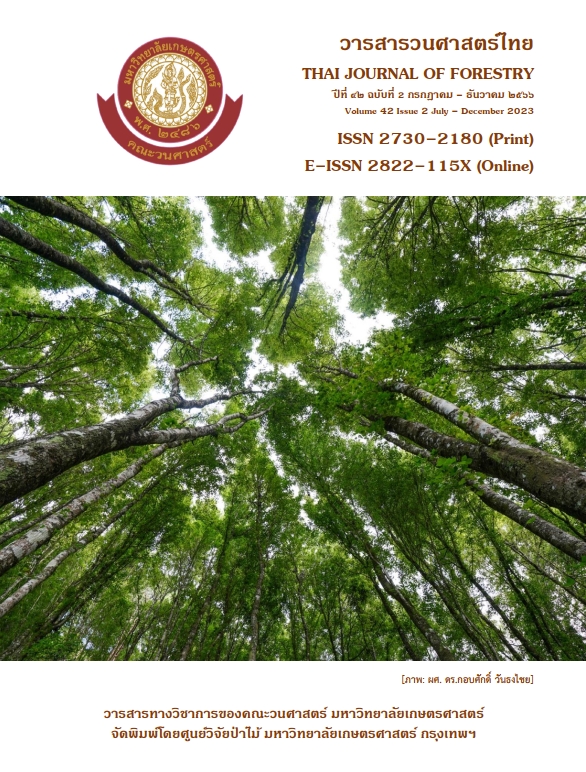การศึกษาการเปลี่ยนแปลงสภาพพื้นที่ป่าระหว่างปี พ.ศ. 2556-2565 ในพื้นที่อุทยานแห่งชาติศรีลานนา จังหวัดเชียงใหม่
Main Article Content
บทคัดย่อ
การศึกษาครั้งนี้มีวัตถุประสงค์เพื่อประยุกต์ใช้เทคโนโลยีการสำรวจระยะไกล ในการตรวจสอบการเปลี่ยนแปลงของพื้นที่ป่าบริเวณอุทยานแห่งชาติศรีลานนา จังหวัดเชียงใหม่ระหว่างปี พ.ศ. 2556–2565 ระยะเวลา 10 ปี โดยใช้ข้อมูลจากดาวเทียม Landsat 8 OLI แปลตีความด้วย Computer based classification ใชเทคนิคการจำแนกประเภทข้อมูลแบบกำกับดูแล (supervised classification) ร่วมกับเทคนิควิธีการแปลภาพด้วยสายตา (visual interpretation) รวมถึงใช้ระบบสารสนเทศภูมิศาสตร์ (geographic information system: GIS) เข้ามาช่วยจัดการข้อมูล ทำการตรวจสอบความถูกต้องของการแปลข้อมูลภาพ โดยกำหนดจำนวนจุดที่ใช้ในการตรวจสอบไม่น้อยกว่า 500 จุด รอบบริเวณอุทยานแห่งชาติศรีลานนา ด้วยตาราง Error matrix หรือ Confusion matrix และค่าสถิติแคปปา (Kappa statistics)
จากการแปลตีความข้อมูลดาวเทียม Landsat 8 OLI ในบริเวณอุทยานแห่งชาติศรีลานนา พบว่าพื้นที่ป่า ระหว่างปี 2556–2557 ลดลง 4,439 ไร่ (710.24 เฮกตาร์) ซึ่งเป็นช่วงปีที่พื้นที่ป่าลดลงมากที่สุด ปี 2557–2558 ลดลง 1,308 ไร่ (209.28 เฮกตาร์) ปี 2558–2559 ลดลง 605 ไร่ (96.8 เฮกตาร์) ปี 2559–2560 ลดลง 1,988 ไร่ (318.08 เฮกตาร์) ปี 2560–2561 ลดลง 863 ไร่ (138.08 เฮกตาร์) ปี 2561–2562 ลดลง 297 ไร่ (47.52 เฮกตาร์) ปี 2562–2563 ลดลง 353 ไร่ (57.28 เฮกตาร์) ปี 2563–2564 ลดลง 386 ไร่ (61.76 เฮกตาร์) และปี 2564–2565 ลดลง 153 ไร่ (24.48 เฮกตาร์) ซึ่งเป็นการลดลงของพื้นที่ป่าที่น้อยที่สุดในช่วง 10 ปีที่ผ่านมา และผลการการตรวจสอบข้อมูลความถูกต้องในแต่ละปี Overall accuracy มีค่าเฉลี่ยประมาณร้อยละ 85.54 และค่าสถิติแคปปา ที่ 77.74 และพบแนวโน้มของพื้นที่ป่าจากสมการ Polynomial order 3 y = -0.0322x3 + 195.19x2 - 394313x + 3E+08 และ R² = 0.9789
Downloads
Article Details

อนุญาตภายใต้เงื่อนไข Creative Commons Attribution-NonCommercial-NoDerivatives 4.0 International License.
ข้าพเจ้าและผู้เขียนร่วม (ถ้ามี) ขอรับรองว่า ต้นฉบับที่เสนอมานี้ยังไม่เคยได้รับการตีพิมพ์และไม่ได้อยู่ในระหว่างกระบวนการพิจารณาตีพิมพ์ลงในวารสารหรือสิ่งตีพิมพ์อื่นใด ข้าพเจ้าและผู้เขียนร่วม (ถ้ามี) ยอมรับหลักเกณฑ์และเงื่อนไขการพิจารณาต้นฉบับ ทั้งยินยอมให้กองบรรณาธิการมีสิทธิ์พิจารณาและตรวจแก้ต้นฉบับได้ตามที่เห็นสมควร พร้อมนี้ขอมอบลิขสิทธิ์ผลงานที่ได้รับการตีพิมพ์ให้แก่วารสารวนศาสตร์ คณะวนศาสตร์ มหาวิทยาลัยเกษตรศาสตร์ กรณีมีการฟ้องร้องเรื่องการละเมิดลิขสิทธิ์เกี่ยวกับภาพ กราฟ ข้อความส่วนใดส่วนหนึ่ง หรือ ข้อคิดเห็นที่ปรากฏในผลงาน ให้เป็นความรับผิดชอบของข้าพเจ้าและผู้เขียนร่วม (ถ้ามี) แต่เพียงฝ่ายเดียว และหากข้าพเจ้าและผู้เขียนร่วม (ถ้ามี) ประสงค์ถอนบทความในระหว่างกระบวนการพิจารณาของทางวารสาร ข้าพเจ้าและผู้เขียนร่วม (ถ้ามี) ยินดีรับผิดชอบค่าใช้จ่ายทั้งหมดที่เกิดขึ้นในกระบวนการพิจารณาบทความนั้น”
เอกสารอ้างอิง
Chuchip, K. 2018. Accuracy Assessment: Remote Sensing Technical. Faculty of Forestry, Kasetsart University, Bangkok, Thailand. (in Thai)
Department of Provincial Administration. 2022. Population Statistical Data Structure. https://stat.bora.dopa.go.th/new_stat/webPage/statByYear.php, 1 March 2023.
Frankin, S.E. 2001. Remote Sensing for Sustainable Forest Management. Boca Raton London, New York, USA.
USGS Science for a Changing World. 2016. Landsat 8 OLI and TIRS and Their Uses. https://www.usgs.gov/media/images/landsat-8-oli-and-tirs-and-their-uses, 1 March 2023.
Geo-Informatics and Space Technology Development Agency (Public Organization). 2009. Space Technology and GEO-Informatics. Geo-Informatics and Space Technology Development Agency (Public Organization), Bangkok, Thailand. (in Thai)
Office of the Auditor General of Thailand. 2010. Investigation of Conservation, Reforestation and Protection of Forest Resources of Department of National Parks, Wildlife and Plant Conservation. Office of the Auditor General of Thailand, Bangkok, Thailand. (in Thai)
Office of the Secretary of the National Strategy Committee. 2018. National Strategy 2018 – 2037. Office of the National Economics and Social Development Council, Bangkok, Thailand. (in Thai)
Planning and Information Office. 2021. Government Action Plan 2022 Office Department of National Parks, Wildlife and Plant Conservation. Department of National Parks, Wildlife and Plant Conservation, Bangkok. (in Thai)
Pongtong, P., Wongsiwawilas, T. 2015. The natural resources and environmental management: forest resources and biodiversity. The National Defence College of Thailand Journal, 57(2): 19-30. (in Thai)
Rungrưang, K. 2013. The Management of Geography Instruction. Suweeriyasarn, Bangkok, Thailand. (in Thai)
Si Lanna National Park. 2018. Management Plan Sri Lanna National Park 2019-2023. Sri Lanna National Park, Chiang Mai, Thailand. (in Thai)
U.S. Department of the Interior. 2016. Using the USGS Landsat Level-1 Data Product. https://www.usgs.gov/landsat-missions/using-usgs-landsat-level-1-data-product, 1 March 2023.


